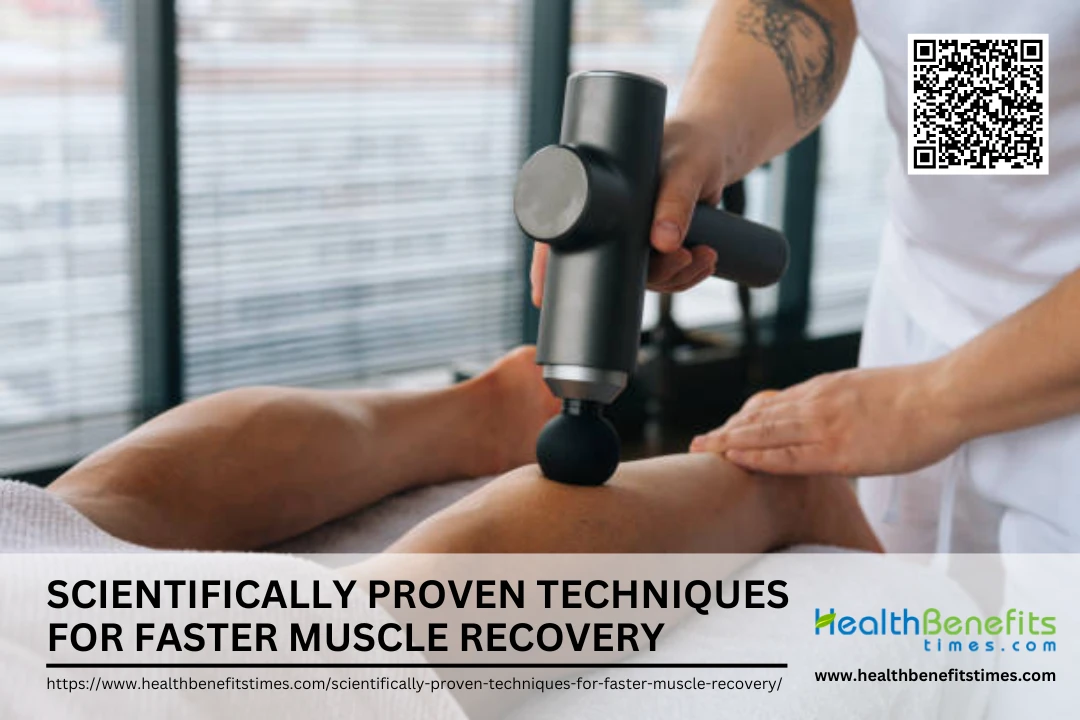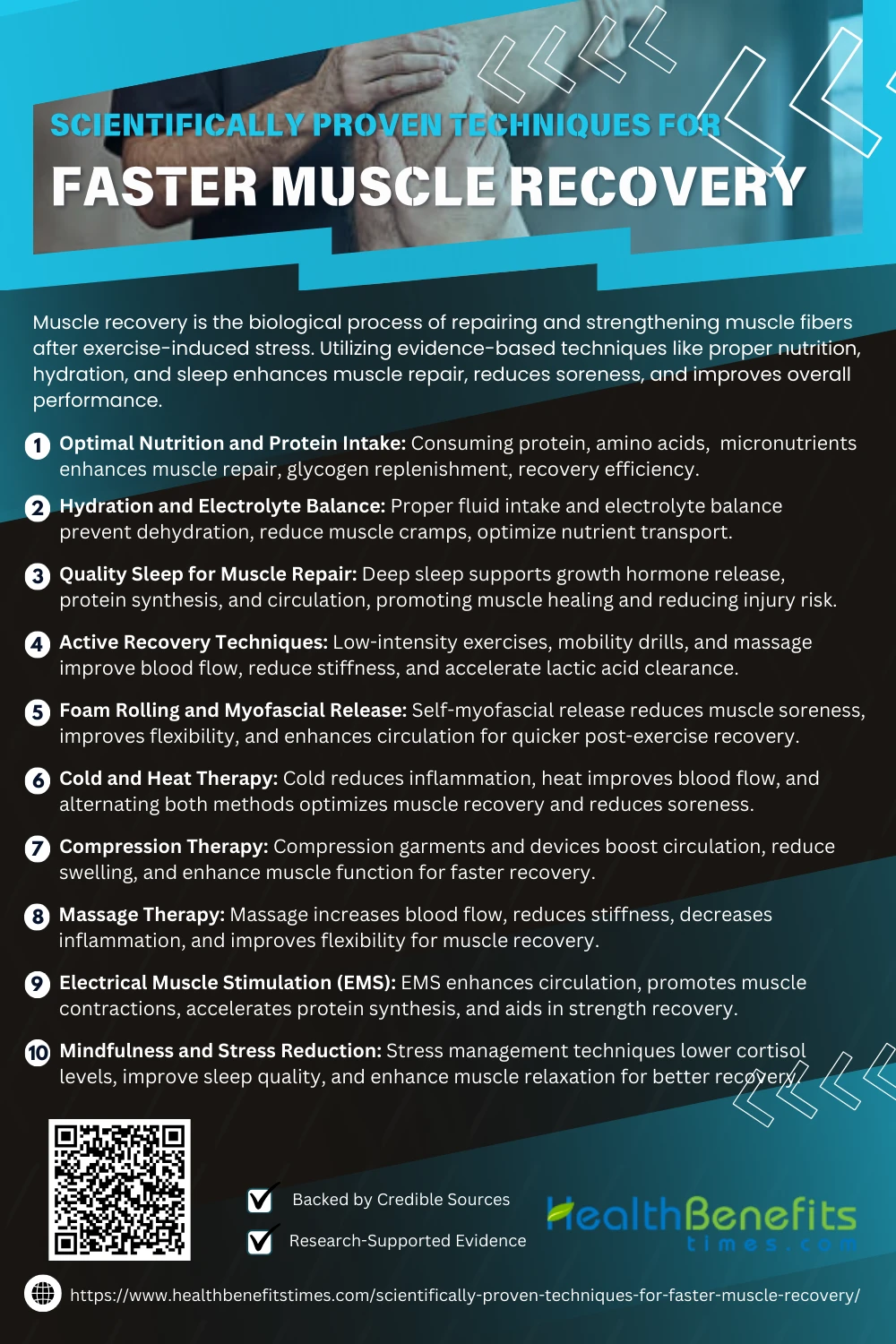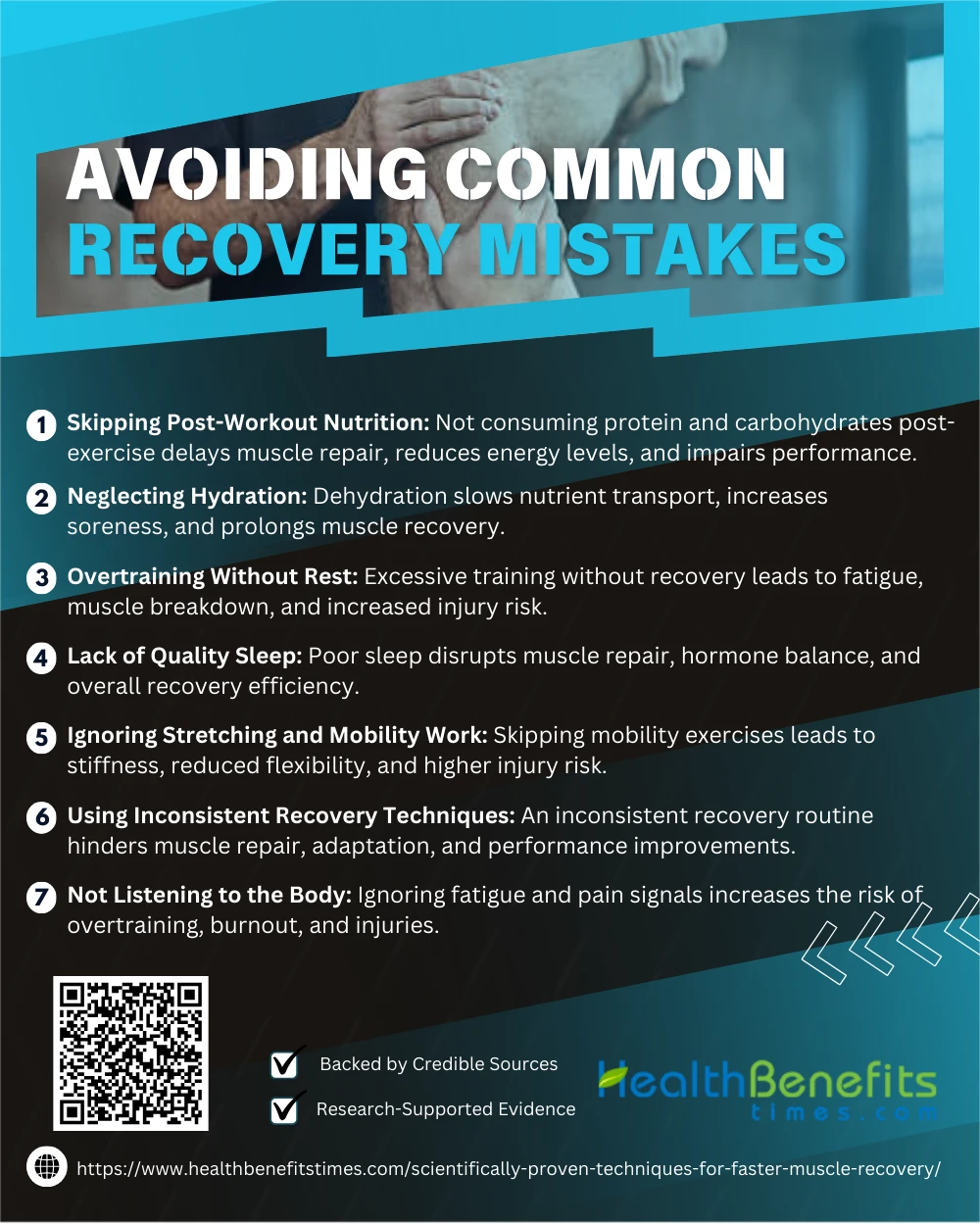- Muscle recovery is the biological process of repairing and strengthening muscle fibers after exercise-induced stress.
- Utilizing evidence-based techniques like proper nutrition, hydration, and sleep enhances muscle repair, reduces soreness, and improves overall performance.
- Active recovery, massage, cold therapy, and adequate protein intake accelerate healing and minimize fatigue for faster and more effective muscle recovery.
 Muscle recovery is the biological process through which the body repairs and rebuilds muscle fibers after exercise, reducing inflammation and restoring strength for optimal performance. The importance of muscle recovery cannot be overstated, as it significantly affects athletic performance, injury prevention, and overall well-being. Research indicates that various scientifically-backed techniques can accelerate muscle repair, ranging from mild aerobic exercise to targeted therapies. Proper nutrition, including adequate protein intake and hydration, plays a fundamental role in replenishing glycogen stores and promoting muscle synthesis. Additionally, sleep has been identified as a crucial factor in muscle recovery, with studies highlighting its role in optimizing growth hormone production and reducing muscle fatigue. Emerging recovery methods such as cryotherapy and compression therapy have also demonstrated efficacy in reducing post-exercise muscle soreness and inflammation. Active recovery, including low-intensity movement and stretching, has been found to enhance circulation and decrease recovery time. Moreover, electrical muscle stimulation (EMS) has gained attention for its ability to enhance muscle repair and mitigate fatigue. Lastly, stress management techniques such as mindfulness and meditation have been shown to improve overall recovery by regulating cortisol levels.
Muscle recovery is the biological process through which the body repairs and rebuilds muscle fibers after exercise, reducing inflammation and restoring strength for optimal performance. The importance of muscle recovery cannot be overstated, as it significantly affects athletic performance, injury prevention, and overall well-being. Research indicates that various scientifically-backed techniques can accelerate muscle repair, ranging from mild aerobic exercise to targeted therapies. Proper nutrition, including adequate protein intake and hydration, plays a fundamental role in replenishing glycogen stores and promoting muscle synthesis. Additionally, sleep has been identified as a crucial factor in muscle recovery, with studies highlighting its role in optimizing growth hormone production and reducing muscle fatigue. Emerging recovery methods such as cryotherapy and compression therapy have also demonstrated efficacy in reducing post-exercise muscle soreness and inflammation. Active recovery, including low-intensity movement and stretching, has been found to enhance circulation and decrease recovery time. Moreover, electrical muscle stimulation (EMS) has gained attention for its ability to enhance muscle repair and mitigate fatigue. Lastly, stress management techniques such as mindfulness and meditation have been shown to improve overall recovery by regulating cortisol levels.
Understanding Muscle Recovery
Muscle recovery is a complex biological process that involves muscle fiber repair, inflammation reduction, and adaptation to physical stress. The physiology of muscle recovery depends on protein synthesis, cellular repair, and inflammatory response, which are influenced by factors such as exercise intensity, nutrition, and rest. Key factors affecting recovery include hydration, sleep quality, and hormonal balance, which play crucial roles in optimizing performance and preventing muscle fatigue. Additionally, age, genetics, and overall health impact the rate at which muscles repair and adapt to exercise. Understanding these physiological mechanisms allows for the implementation of effective recovery strategies that enhance strength, endurance, and overall fitness.
Difference between muscle fatigue, soreness (DOMS), and injury
| Feature | Muscle Fatigue | Muscle Soreness (DOMS) | Muscle Injury |
| Definition | Temporary reduction in muscle performance due to prolonged exertion | Delayed onset muscle soreness (DOMS) caused by microtears in muscle fibers after unaccustomed exercise | Damage to muscle fibers, tendons, or ligaments due to excessive force, overuse, or trauma |
| Onset | During or immediately after exercise | 12–72 hours after intense or new exercise | Sudden (acute injury) or gradual (chronic injury) |
| Cause | Depletion of energy stores, accumulation of metabolic byproducts (e.g., lactic acid) | Eccentric contractions leading to microscopic muscle damage and inflammation | Overstretching, direct impact, excessive strain, or repetitive stress |
| Symptoms | Weakness, decreased muscle power, heavy feeling | Stiffness, tenderness, swelling, mild loss of strength | Sharp pain, swelling, bruising, limited mobility, possible popping sound (for acute injuries) |
| Duration | Resolves within a few hours after rest | Peaks within 24–48 hours, resolves in 3–7 days | Varies (mild strains heal in days to weeks, severe injuries may require months) |
| Recovery Methods | Rest, hydration, electrolyte replenishment, light stretching | Active recovery, massage, foam rolling, ice/heat therapy | RICE (Rest, Ice, Compression, Elevation), physical therapy, medical intervention if severe |
| Prevention | Proper warm-up, balanced nutrition, pacing exercise intensity | Gradual progression in training, proper cool-down, stretching | Strength training, proper technique, avoiding overtraining |
Scientifically Proven Techniques for Faster Muscle Recovery
Muscle recovery is the process of repairing and strengthening muscle tissue after exercise. Using scientifically proven techniques like proper nutrition, hydration, sleep, and active recovery can accelerate healing and enhance performance.
1. Optimal Nutrition and Protein Intake
Proper nutrition plays a vital role in muscle recovery by providing essential macronutrients like protein, which promotes muscle repair and adaptation. (1) Studies highlight that consuming high-quality protein sources, such as whey and casein, enhances muscle synthesis and reduces recovery time. (2) Additionally, amino acids, particularly BCAAs, accelerate muscle repair by reducing exercise-induced muscle damage. (1) Hydration and micronutrients, including magnesium and vitamin D, further optimize protein metabolism for faster recovery. (3) Combining protein with carbohydrates post-exercise also replenishes glycogen stores, boosting recovery efficiency. (4)
2. Hydration and Electrolyte Balance
Proper hydration is essential for muscle recovery, as it aids in nutrient transport and waste removal, reducing muscle cramps and fatigue. (5) Maintaining electrolyte balance prevents dehydration-related muscle damage and optimizes fluid retention for faster recovery. (6) Studies show that sodium, potassium, and magnesium play critical roles in preventing muscle soreness and accelerating repair. (7) Electrolyte-enhanced drinks have been found to improve hydration efficiency post-exercise. (8) Additionally, consuming fluids with carbohydrates promotes glycogen replenishment and reduces fatigue. (9)
3. Quality Sleep for Muscle Repair
Sleep plays a crucial role in muscle recovery by promoting growth hormone release and tissue repair. (10) Studies indicate that poor sleep quality impairs protein synthesis and delays muscle recovery. (1) Deep sleep stages enhance blood circulation, providing oxygen and nutrients to muscles for faster healing. (11) Athletes with consistent sleep patterns show improved endurance and reduced injury risk. (12) Moreover, sleep deprivation leads to increased cortisol levels, which slow down muscle regeneration and increase fatigue. (13)
4. Active Recovery Techniques
Active recovery techniques, such as low-intensity exercises like cycling and swimming, enhance blood flow and reduce muscle stiffness. (14) Studies show that active recovery decreases lactic acid buildup, accelerating muscle healing. (15) Research on early weight-bearing exercises demonstrates faster recovery with reduced injury risk. (16) Post-exercise mobility drills improve muscle oxygenation and prevent soreness. (17) Additionally, sports massage combined with active stretching is proven to enhance circulation and relieve fatigue. (18)
5. Foam Rolling and Myofascial Release
Foam rolling and self-myofascial release (SMR) reduce muscle tension and enhance flexibility, aiding post-exercise recovery. (19) Studies indicate that SMR helps decrease delayed onset muscle soreness (DOMS) and accelerates muscle relaxation. (20) Research on thermal imaging shows that foam rolling normalizes muscle temperature faster than passive recovery methods. (20) Athletes using SMR experience improved mobility and faster neuromuscular adaptation. (21) Furthermore, regular foam rolling post-training can enhance muscle elasticity and reduce injury risk. (20)
6. Cold and Heat Therapy
Cold and heat therapy are effective techniques for muscle recovery, with cold reducing inflammation and heat improving blood circulation. Research shows that cold therapy, such as ice baths, minimizes muscle damage and accelerates healing. (22) Heat therapy, on the other hand, enhances muscle elasticity and reduces stiffness. (23) A combination of both methods has been found to optimize recovery by reducing muscle soreness. (24) Cold therapy is particularly beneficial after high-intensity workouts, while heat therapy aids in long-term recovery. (25) Alternating between cold and heat treatments improves muscle function and accelerates recovery time. (23)
7. Compression Therapy
Compression therapy is widely used to enhance circulation and reduce muscle fatigue. Studies indicate that wearing compression garments post-exercise reduces muscle soreness and swelling. (26) Compression therapy increases blood flow, facilitating oxygen and nutrient delivery to muscles for faster recovery. (27) Research shows that intermittent compression devices improve venous return and decrease inflammation. (28) Athletes using compression therapy report improved muscle function and reduced recovery time compared to passive rest. (29) Additionally, compression therapy aids in preventing muscle stiffness and injury, making it an essential tool for recovery and performance enhancement. (30)
8. Massage Therapy
Massage therapy enhances muscle recovery by increasing blood circulation, reducing stiffness, and promoting relaxation. Research indicates that sports massage significantly decreases delayed onset muscle soreness (DOMS) and improves flexibility. (31) Thai massage has been found to enhance lower leg muscle recovery and reduce fatigue. (31) Studies highlight that massage therapy combined with physiotherapy accelerates muscle repair. (24) Research also supports the effectiveness of deep tissue massage in reducing post-exercise inflammation. (32) Additionally, combining massage with foam rolling has been shown to optimize recovery and reduce injury risk. (33)
9. Electrical Muscle Stimulation (EMS)
Electrical Muscle Stimulation (EMS) has been shown to enhance muscle recovery by improving circulation and reducing soreness. Research indicates that EMS accelerates the removal of metabolic waste, reducing post-exercise muscle fatigue. (34) Studies show that EMS therapy stimulates muscle contractions, enhancing protein synthesis for faster tissue repair. (34) EMS is also effective in enhancing blood circulation, leading to faster oxygenation and nutrient delivery to fatigued muscles. (34) Research highlights that EMS can be used as an adjunct to traditional recovery methods, helping athletes recover faster from intense training. (34) Additionally, EMS has been found to aid in muscle activation and strength recovery, reducing the risk of long-term injuries. (34)
10. Mindfulness and Stress Reduction
Mindfulness and stress reduction techniques play a crucial role in muscle recovery by lowering cortisol levels and promoting relaxation. Studies show that mindfulness meditation enhances parasympathetic nervous system activity, improving recovery efficiency. (1) Yoga and deep breathing exercises help reduce muscle tension and inflammation, accelerating healing. (1) Research suggests that guided imagery and progressive muscle relaxation significantly reduce post-exercise soreness. (1) Athletes practicing mindfulness experience better sleep quality, leading to enhanced muscle repair. (1) Additionally, stress-reducing techniques like Tai Chi have been linked to faster muscle regeneration and reduced injury risk. (1)
Avoiding Common Recovery Mistakes
Avoiding common recovery mistakes is crucial for muscle repair. Overtraining, poor nutrition, dehydration, and lack of sleep hinder recovery. Ignoring rest days and skipping warm-ups or cool-downs can also delay muscle healing.
1. Skipping Post-Workout Nutrition
Skipping post-workout nutrition can delay muscle repair, impair glycogen replenishment, and increase fatigue. Research highlights that consuming protein and carbohydrates post-exercise enhances recovery by optimizing muscle protein synthesis. (35) A well-timed post-workout meal helps maintain energy levels and prevent muscle breakdown. (36) Studies suggest that inadequate post-exercise nutrition negatively affects strength recovery and overall performance. (37)
2. Neglecting Hydration
Neglecting hydration slows muscle recovery by reducing nutrient transport and increasing muscle soreness. Research indicates that dehydration impairs muscle function and prolongs fatigue. (38) Proper hydration supports electrolyte balance, preventing cramps and enhancing recovery efficiency. (38) Studies show that replenishing fluids post-exercise accelerates metabolic waste removal and optimizes muscle repair. (38)
3. Overtraining Without Rest
Overtraining without adequate rest leads to chronic fatigue, muscle breakdown, and decreased performance. Research highlights that recovery periods prevent underperformance and overtraining syndrome (Kellmann, 2002). Studies indicate that excessive training without rest reduces immune function and increases injury risk. (39) Monitoring training loads and incorporating rest days optimizes performance and prevents burnout. (40)
4. Lack of Quality Sleep
Lack of quality sleep impairs muscle recovery, hormone regulation, and cognitive function. Research shows that sleep deprivation disrupts the body’s ability to repair muscles and regulate stress hormones. (41) Studies indicate that insufficient sleep contributes to burnout and decreased energy levels. (42) Prioritizing sleep enhances overall recovery, performance, and psychological well-being. (43)
5. Ignoring Stretching and Mobility Work
Neglecting stretching and mobility exercises can lead to muscle stiffness, reduced flexibility, and increased injury risk. Research highlights that mobility work enhances range of motion and accelerates post-exercise recovery. (44) Studies indicate that dynamic stretching before exercise and static stretching post-workout reduce muscle tension and soreness. (45) Regular flexibility training has been shown to prevent muscle imbalances and improve athletic performance. (46)
6. Using Inconsistent Recovery Techniques
Using inconsistent recovery techniques can slow muscle repair and lead to performance plateaus. Studies show that maintaining a structured recovery routine enhances adaptation and reduces injury risk. (47) Research suggests that combining evidence-based recovery methods, such as active recovery and massage, optimizes muscle function. (48) Skipping essential recovery strategies, like hydration and proper nutrition, hinders muscle regeneration and increases fatigue. (48)
7. Not Listening to the Body
Ignoring signs of fatigue, pain, or discomfort can lead to overtraining and injuries. Research emphasizes that self-awareness in recovery enhances long-term athletic performance. (49) Studies show that mindful listening to the body’s signals prevents burnout and optimizes rest cycles. Athletes who adjust training intensity based on physiological feedback experience improved recovery and reduced injury risk.
Debunking Recovery Myths
Muscle recovery is a critical component of fitness, yet many misconceptions persist that can hinder progress and even increase the risk of injury. Understanding the truth behind these myths ensures optimal recovery, muscle growth, and long-term performance.
1. Myth: No Pain, No Gain

Many believe that if they don’t feel sore after a workout, they haven’t trained hard enough. However, research shows that Delayed Onset Muscle Soreness (DOMS) results from microtears in muscle fibers, which is a natural part of adaptation, but soreness is not required for progress. Over time, the body adapts, and soreness decreases, even when strength and endurance improve.
2. Myth: Rest Days Are for the Weak

Some believe that taking a rest day means losing progress. However, muscles grow and repair during rest, not while lifting weights. Overtraining leads to decreased performance, chronic fatigue, and increased injury risk.
3. Myth: Static Stretching Before Exercise Prevents Injuries

Many people stretch statically before workouts, thinking it prevents injury. However, research suggests that static stretching before exercise can actually decrease muscle strength and performance. Dynamic stretching, which involves movement-based stretches, is far more effective.
4. Myth: More Protein Equals Faster Recovery

Protein is essential for muscle repair, but consuming excessive amounts beyond the body’s needs does not speed up recovery. The body can only process a certain amount of protein per meal, and excess protein is either stored as fat or excreted.
5. Myth: Ice Baths Are the Best Recovery Method

Many athletes believe that cold therapy (ice baths, cryotherapy) is the best way to recover after workouts. While ice baths reduce muscle soreness by decreasing inflammation, they may also impair muscle growth and adaptation by reducing the necessary inflammatory response for muscle rebuilding.
Conclusion
Effective muscle recovery is essential for optimizing performance, preventing injuries, and ensuring long-term progress. By incorporating scientifically proven techniques such as proper nutrition, hydration, quality sleep, active recovery, and strategic therapies like massage, compression, and electrical stimulation, individuals can significantly enhance muscle repair. Debunking common recovery myths and adopting evidence-based practices ensures that recovery is efficient and sustainable. Ultimately, listening to the body and maintaining consistency in recovery methods will lead to faster healing, improved strength, and overall better physical performance.




